It is by now cliché to talk about just how badly Pakistan’s educational system is doing, and just how little is being spent upon it. Figures such as ‘less than 2% of GDP’ are thrown about with abandon to indicate how little of a spending priority it is for the government. And while much of what you may have heard about education in Pakistan is negative, the story about the turnaround in Pakistan’s schools, particularly government schools, is real.

But first, let us get a few facts straight. The total proportion of money spent on education in Pakistan is low, but has been rising steadily over the past decade. Government spending on education accounted for just 1.75% of GDP in 2007 and is expected to exceed 2.53% by the end of the ongoing fiscal year ending June 30, a relatively rapid pace of increase.
And it is important to realise that the government is not alone in spending money on students. Parents, in particular, those in urban areas, are highly likely to send their children to private schools if government schools prove to be inadequate. That spending does contribute to the total national investment in education, even though it does not show up in the government’s numbers. According to estimates compiled by Profit, using data from the Pakistan Bureau of Statistics, that spending adds between 1.4% and 2% of GDP in any given year to total educational spending.
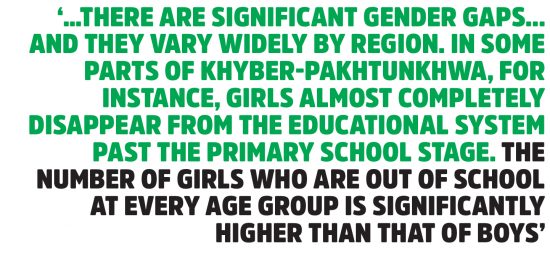
In short, the total sum being spent on education (not including any philanthropic spending) is expected to hit 4.2% this year, compared to just 3.0% as recently as 2011.
Moreover, it appears that the campaign by nonprofits like Alif Ailaan to promote the idea that the dilapidated state of public education in Pakistan constitutes a national emergency appears to have worked. Governments, both federal and provincial, have dramatically expanded not just the monetary resources they make available to schools, but also a significant proportion of the managerial attention of chief ministers and chief secretaries in the provinces. (Since the near-simultaneous passage of the 18th Amendment to the Constitution and the Seventh National Finance Commission Award, much of the action on education now takes place at the provincial level.)
On a per-student basis, the country is projected to spend approximately Rs2,300 per month in fiscal year 2018, compared to just Rs633 per student per month in FY2007, an increase of about 12.4% per year on average during that time. Encouragingly, government spending during that time has outpaced private spending: 13.3% per year on average, compared to 11.3% per year for parents spending on private schools.

Here is why that is relevant: provincial governments claiming that their improvements in the quality of schools is having a real impact on the ground is now measurable in the data: aggregate spending by parents on private schools and colleges was down sharply between 2014 and 2016, according to data from the Pakistan Bureau of Statistics. That period coincides with the first wave of massive school improvements – mostly in terms of physical infrastructure – in Punjab and Khyber-Pakhtunkhwa, and, to a lesser extent, in Sindh.
In other words, public schools have improved so much in some parts of the country that parents are taking their children out of private schools and putting them into government schools.
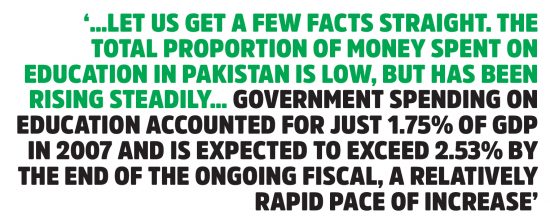
We as Pakistanis are rarely used to seeing our government doing something right, so it is tempting to feel elated that they have chosen to do so on something so monumentally consequential as the education of our children. But there is significantly more work to be done.
For starters, the money being spent right now is almost entirely on the physical infrastructure of schools as well as putting in more effective monitoring systems to ensure that school teachers actually show up to teach, and that children are actually in school, and to a slightly lesser extent, to whether the students who are in school are actually learning.
Gaps that need plugging
There are, however, several gaps that still need to be filled. Firstly, there are wide geographic variations in the effectiveness of these reforms. Punjab has a massive headstart, though Khyber-Pakhtunkhwa is rapidly catching up. Sindh and Balochistan are starting to pay attention, but are still far behind. About 88% of children in Punjab enroll in primary schools, compared to just 58% in Balochistan.
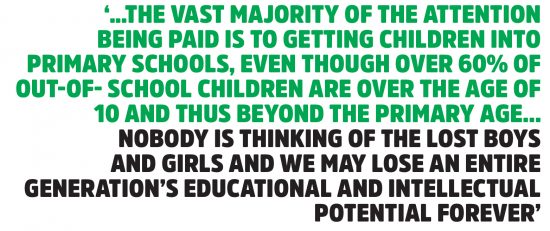
Secondly, there are significant gender gaps still in the educational system, and they vary widely by region. In some parts of Khyber-Pakhtunkhwa, for instance, girls almost completely disappear from the educational system past the primary school stage. The number of girls who are out of school at every age group is significantly higher than that of boys. For instance, the government estimates that, in 2016, there were 10.5 million boys out of school at all school-going age groups (age 5 through 18), but 12.1 million girls out of school in the same age groups.
Thirdly, the vast majority of the attention being paid is to getting children into primary schools, even though over 60% of children who are out of school are over the age of 10 and thus beyond the primary school age. In short, nobody is thinking of the lost boys and girls and we may lose an entire generation’s educational and intellectual potential forever.
Fourthly, and perhaps most critically, there are very few attempts to make the curriculum more geared towards critical thinking skills and away from rote memorisation. On this front, there appears to be relatively little progress being made in any province.

……..
Areas of agreement and debate
Nooni: So, I think it is safe to say that there are probably significant areas of agreement here.
Insafian: Yes, there are. We both agree that too many children are out of school, and that too many schools had unacceptable deficiencies in their infrastructure that need to be fixed.
Nooni: Right, so let’s address the common critique that we both get for our approaches, which has thus far focused heavily on improving the physical infrastructure of schools: you need to have a school first – with buildings, classrooms, and students all regularly there – before you can start improving other aspects of educational quality.
Insafian: Agreed. It’s not as though either of us believes that we should not be focusing on other aspects. It’s just that the physical infrastructure is so basic and so horribly lacking in large parts of the country, that we need to dedicate a lot of our resources to that before we can truly focus on anything else.
Nooni: Right, so another area we agree on is driving the existing bureaucracy to do their job better, holding them accountable, and tracking progress through regularly measurable metrics.
Insafian: Yes… but I’ll add a caveat to that. So, it’s not as though I don’t agree that measuring success is important, but I do think that you guys are way too obsessed with measuring performance and not enough with actually improving the quality of education.
Nooni: That’s a bit of a loaded statement. How could you possible know whether the quality of education is improving or not if you don’t measure it?
Insafian: I’m not saying don’t measure it. I’m just saying that you should not be so obsessed with quality measures that bureaucrats start feeling the need to lie to you about the numbers, which is what has now started happening in Punjab.
Nooni: Firstly, that’s an unproven allegation. Secondly, we have a check on that by hiring external consultants to audit and validate all numbers.
Insafian: We clearly disagree on the efficacy of that methodology, so let’s move on.
Nooni: Okay, let’s talk about the language of instruction. What’s up with trying to implement English as a language of instruction in schools in Khyber-Pakhtunkhwa?
Insafian: We want to end the educational apartheid in Pakistan that places Anglophones over and above the rest of the population. We can’t keep denying the vast majority of our population the right to get ahead economically.
Nooni: Sure, but is changing the language of instruction really the best way to do it when even the teachers don’t know the language?
Insafian: Look, the only way we end this class divide is by giving more children exposure to English at an earlier age and across a wider array of subjects.
Nooni: That still doesn’t answer my question. But I’ll say this: we tried this in Punjab a while ago and it ended in failure. Trust us: you’re better off without it.
Insafian: A bit rich coming from a province that is imposing Urdu on a population that mostly speaks Punjabi and Seraiki
Nooni: Touché, though we would point out that Urdu is a lot easier for Punjabi and Seraiki speakers than English.
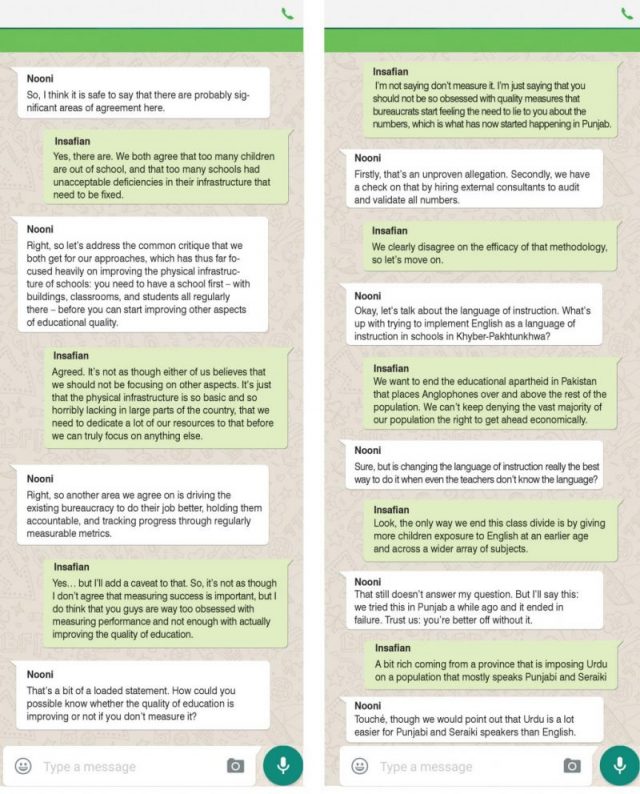



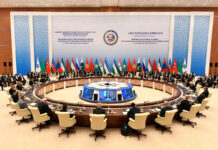
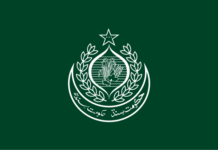

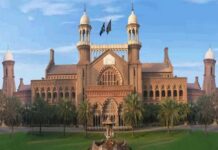















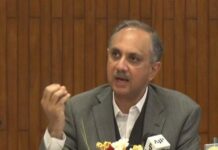
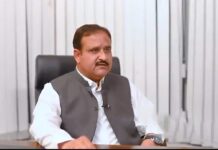
Govt should need to make policy to improve education in Pakistan.
Comments are closed.